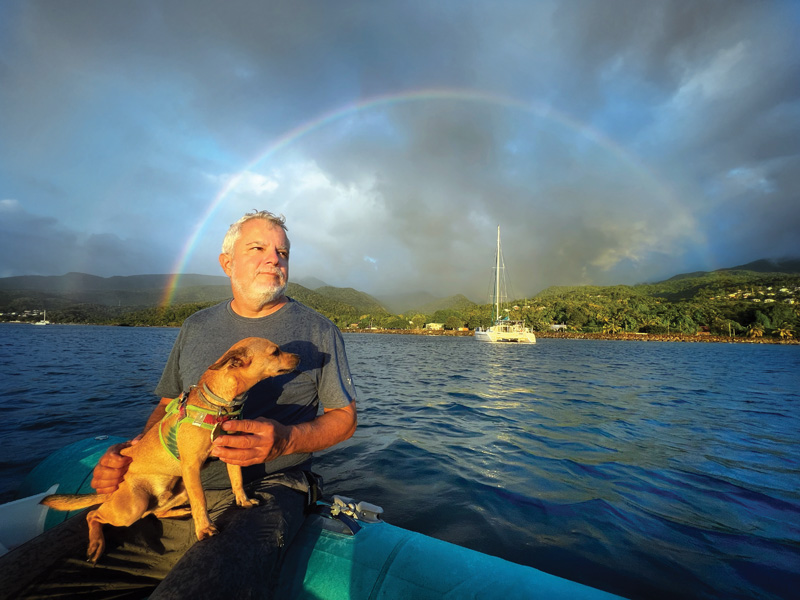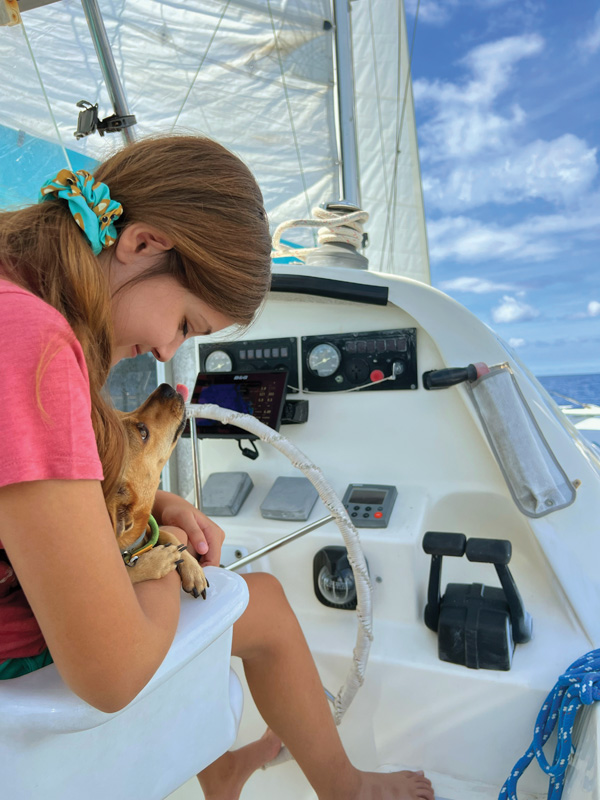Pets onboard are an equal mix of hard work and joyful rewards.
On our first foray into cruising, we departed the Chesapeake with a 50-pound German Shepherd-Chow mix and spent some time sailing around the Bahamas and Cuba. When we returned to the Chesapeake, we swore to each other that we would never cruise outside the country with a dog again. Now we are cruising in the Caribbean with two dogs. Sigh.

Pets onboard are an equal mix of hard work and joyful rewards. In a life largely unplugged, nothing beats the furry companionship of a kitty snuggle on a stormy day, or the pure joy of a dog playing with hermit crabs on the beach. However, in stiff wind and a strong swell, nothing makes you regret cruising with a dog more than a salty dinghy ride to shore while everyone else is dry and cozy. Many people pass their critters on to a trusted friend when they go cruising long term, and some wait until their pet crosses the rainbow bridge before they cast off. We are the ones who decided that family is family, furry or not, and committed to the ups and downs of cruising with our pets.
Feeding pets onboard
First let’s look at feeding. Most dogs and cats eat a dry kibble, and that’s thankfully available all over the Caribbean and Central America. We get different food island to island, and just mix it all together in a big bin. Wet pet food is widely available, too, but brands will vary. If you have a picky pet, it’s time to break that habit. It’s also important to have a dry place to store pet food. Big bins that have a tight seal are a good investment. Humidity and insects are the enemy.
Then, there’s water, the fresh and salty kind. Make sure your freshwater plans include enough for your pets. They need plenty to stay hydrated, and little paws need rinsing after going to the beach or for a swim. If your pup licks all of that salt off his paws, he can get a nasty tummy bug. Trust me, there’s nothing quite as awful as sharing a small space with a dog who has intestinal issues.
Plan ahead and stock up
Speaking of things you don’t want to share your small space with, fleas and ticks are everywhere, but flea and tick prevention medicines are not easily found outside the United States. Plan ahead and stock up on whatever medicines you and your vet choose for internal and external parasite control, and also basic flea and tick collars. Outside the US, certain countries have rules about needing to show proof of parasite control before entering, so keep records as you go along.

Cruising outside the US with pets onboard
Once you sail outside the US, keeping track of the requirements and paperwork is like a part-time job. Cats are easier. If the cat doesn’t leave the boat, you don’t necessarily have to declare them. If you pull into a marina in a different country though, you’ll have to check the kitty in.
Here’s the thing I wish someone would have told me about cruising outside the US with a pet: You have to have a rabies titer test. This is a blood draw done 30 days or more after a rabies vaccine. It proves that enough of the vaccine is in your pet’s system to be effective. It costs a couple hundred dollars, plus or minus, and takes six to eight weeks for results. There is no way for this to be expedited. If you leave the US without this test, it means you are severely limited in where you can check in with a dog (in short, only US or French islands), or that you’re stuck with an island vet doing the test, which will cost even more and take even longer to process. That rabies titer certificate is your ticket to just about anywhere. Don’t sail away without it. Once you have it, as long as your pet’s rabies vaccine never lapses, you are good to go.
Requirements are different from place to place, and they can change as new officials take over. You will hear all kinds of things through the coconut telegraph, but there is only one truly reliable source, and that’s noonsite.com. They are up to date, and they have the contact email or WhatsApp number for whoever is in charge in each country. It’s always a good idea to email ahead a nice, formal letter stating that you are on a private, US flagged vessel with this and that pets onboard and ask what they need from you before you arrive. They like this. Sucking up goes a long way. Have your documents in order and remain respectful. You are a guest in that country. You and your pet are not entitled to anything.
Once you are cleared in, it’s not over yet. In the Caribbean there are rules and risks to be aware of. While the French islands are the easiest in that they have zero requirements for bringing in your pet, they also have strictly enforced rules about dogs on beaches. Not just off leash dogs, no dogs on the beach at all. Once you get past the Virgin Islands, you need to start being very careful about poison. The farther south you go, the more this is an issue. If you have that dog who loves to put everything in his mouth, a sharp eye and a good leash will serve you well. Stay away from dumpsters, trash cans, and farm areas, where it can be a real issue. When you check in, ask about it, and the local authorities will give you the best information. Also be aware of certain plants and trees that are toxic to animals and humans. Local knowledge goes a long way.

Consider your pets onboard as fury diplomats
That’s a big dose of reality, but don’t let it dampen your enthusiasm for cruising with a pet. We call our dogs our furry diplomats. We have made some of our closest friends because of the dogs. We are friends with vets all around the Caribbean who have given our animals top-notch care, from basic checks to surgeries. If you’re a dog owner, your pup will guard your boat loyally. Even our wee chihuahua is a deterrent, because it’s always going to be easier to rob a boat without a noise maker. If you’re really soft hearted, you might end up picking up a coconut hound, the island name for a stray. It happens, trust me.
What onboard pet owners need:
Most countries don’t treat their animals like family, so don’t expect fully stocked pet stores. Stock extras.
- Leashes. Salt water and sand can make your leash attachment seize up. Have spares and stow them somewhere dry.
- Collars and tags. Cats and dogs need a collar with a proper ID tag. Consider making a tag with a photo of your boat and how to get ahold of you while cruising. Collars get gross quickly; keep some spares.
- Beds. Bulky items such as pet beds are difficult to wash. Get one with a removable cover or slide an old T-shirt over it.
- Dog poop bags. Don’t be that person; pick it up. In the French Caribbean you will be told to pick it up, quite firmly. The irony is that you can’t buy poop bags in most of the Caribbean, so get a lot and then some more.
- Nail clippers and treats. These are also hard to come by. Clippers get rusty and seize up, and treats can get moldy in the tropics. Bring extras. Store it all carefully.
by Cindy Wallach
About the Author: Longtime SpinSheet columnist Cindy Wallach is cruising the Caribbean with her family and two dogs aboard their St. Francis 44 catamaran Majestic, which is for sale. Learn more at majesticstfrancis44forsale.com.




